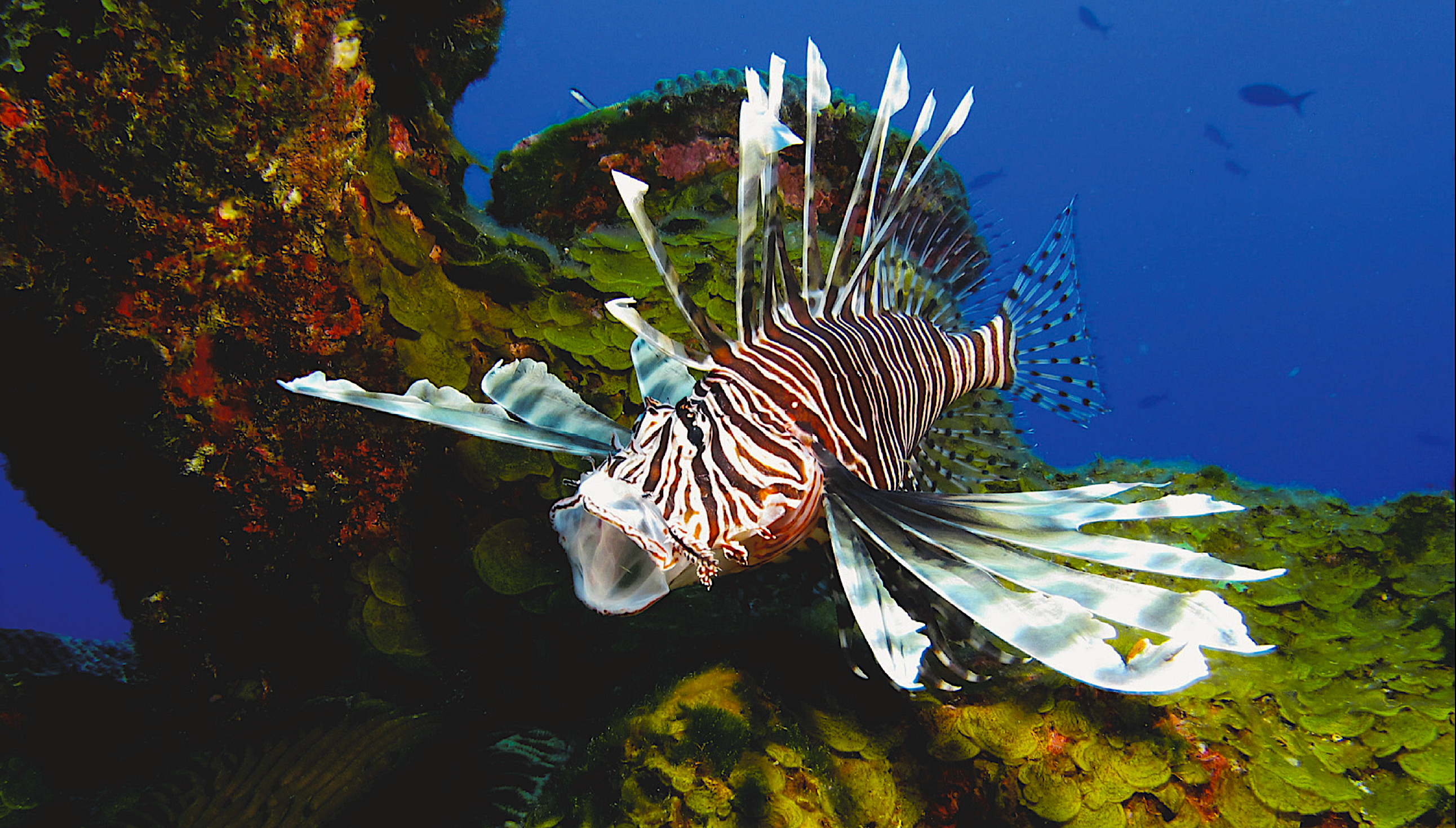North Carolina’s coast is a popular destination for scuba divers. Mysteries of pirates and shipwrecks have lured people from all over the world. Now a new spectacle — lionfish — is intriguing divers and scientists.
Tropical lionfish were first noted in North Carolina’s Continental Shelf waters in 2000. Since then, the population has soared.
“In about 10 years they went from nothing to perhaps tens of thousands,” says Andrew Shepard, director of the National Oceanic Atmospheric Administration (NOAA) Undersea Research Center at the University of North Carolina at Wilmington. “If unchecked they could reach millions in the near future.”
Dive charters up and down the coast report seeing lionfish on many of their regular dives. Lee Moore from Discovery Diving in Beaufort easily lists 10 wrecks where lionfish are common.
“Most divers want to see the lionfish because they make good subjects for photography,” he says. But divers are advised to take photos from a distance because lionfish are venomous.
With vibrantly colored red-and-white stripes and long, protruding venomous spines, the lionfish is very popular in the public and private aquarium trade.
The fish are native to the Indo-Pacific region. Biologists believe the species was introduced into the Atlantic Ocean from accidental or intentional aquarium releases. At least one report suggests that lionfish were released from a private aquarium in south Florida during Hurricane Andrew in 1992.
Other releases may have been by small aquarium owners who improperly disposed of the fish — which grow to an maximum of 18 inches and can weigh up to three pounds. These hobbyists likely do not realize the affects this species could have on native marine ecosystems.
DNA DISCOVERIES
For eight years, biologists at NOAA’s Center for Coastal Fisheries and Habitat Research on Pivers Island in Beaufort and researchers at UNCW have been studying lionfish, including where the fish came from, where they are along the East Coast of the United States and off the Bahamas, and where they might be going.
The scientists are conducting genetic research to uncover the source population of the lionfish invasion.
“Based on our findings so far, we know that there are two lionfish species that have invaded the western Atlantic,” says Wilson Freshwater, a research scientist at UNCW.
Each lionfish species has a DNA fingerprint. Research suggests that the lionfish in Atlantic waters initially established off Florida, possibly from the accidental release, and followed the warm Gulf Stream to North Carolina, where they now reside on many popular reefs.
Through genetic analysis, Freshwater and other scientists now think that the initial lionfish population responsible for establishing lionfish in the western Atlantic waters contained two species — Pterois volitans and Pterois miles — and a total of at least 10 females.
“We are still working on their distribution off the Carolinas, which is expanding in depth and range,” Shepard says.
ROV RESEARCH
While some divers report lionfish in shallower waters, scientists must go deep to learn more about the species.
“Lionfish generally live from 40 to 100 meters on shelf live-bottom reefs, which means we cannot trawl them up,” Shepard explains. “We have to use deep-diving technologies to do ecological studies and accurate surveys.”
Divers using various breathing gas mixes can dive to 100 meters, but have very limited bottom time for surveys, according to Shepard.
“We are developing rebreathers that make deep scuba diving easier, not to mention quieter — which can be useful when studying reef fish behavior,” he adds.
Remotely operated vehicles (ROVs) allow biologists to view depths that cannot be reached by divers. ROVs differ from submersibles in that they are much smaller and do not carry people. The ROV connects to its controls via a line called the umbilical. At the controls is a pilot who is typically on the surface of the water, in a boat or inside a submersible.
Video cameras, still cameras and lights mounted on the ROV allow the pilot to guide the robot to document the lionfish. The ROV is equipped to measure conductivity, temperature, depth, light transmission and oxygen. A mechanical arm can sample and grab things of interest — but not fish.
Using data from the divers and the ROVs, biologists are able to study behaviors and compare numbers of lionfish observed in specific locations to observed populations of native species.
ASSESSING IMPACTS
Biologists say they are keeping a close watch on lionfish and the species’ impacts on North Carolina’s marine environment. There is concern that the invaders might affect commercial and recreational fisheries.
Lionfish are feeding on smaller fish that are usually consumed by grouper and other native fish, which could negatively affect the food chain of these commercial species.
“Our biggest concern is how they impact the economic value of the shelf reef ecosystem,” Shepard says. “Recreational and commercial value of reef-related pelagic and benthic species is close to a half-billion dollars each year to the Carolinas.”
To date, no direct impacts of lionfish on North Carolina’s marine reef fish community have been observed, notes James Morris, an ecologist at NOAA’s Center for Coastal Fisheries and Habitat Research in Beaufort.
‘This is likely because the lionfish invasion is still recent,” Morris says. “And estimates of native fish populations are highly uncertain, making it difficult to attribute their decline to lionfish.”
Future research may give insight into controlling the lionfish population. Many biologists believe that complete eradication in Atlantic waters is impossible. “Small-scale eradication might work at specific sites or over small areas,” Freshwater says.
BEHIND THE GLASS
You don’t have to be a diver to get an up-close view of a lionfish. You can visit any one of the three North Carolina Aquariums for a chance to see the Pacific species now invading Atlantic waters.
Visitors to the Roanoke Island aquarium get a glimpse of how lionfish live in the Gulf Stream.
The Pine Knoll Shores aquarium exhibits lionfish in a cylindrical tank that gives a 360-degree view.
Juvenile lionfish are featured at the Fort Fisher aquarium.
For more information on these locations, visit ncaquariums.
Also, NOAA’s National Ocean Service has more information available online. The site includes a video of lionfish, guides for students and teachers, and links to ask an expert or report a lionfish sighting.
This article was published in the Early Summer 2008 issue of Coastwatch.
For contact information and reprint requests, visit ncseagrant.ncsu.edu/coastwatch/contact/.
- Categories:



